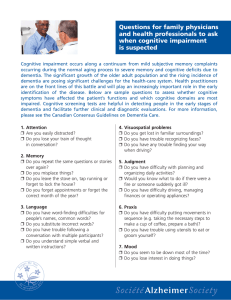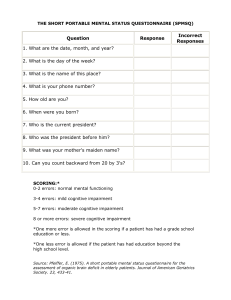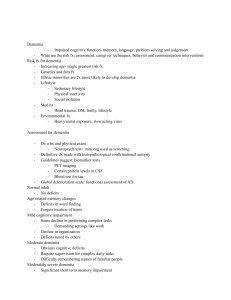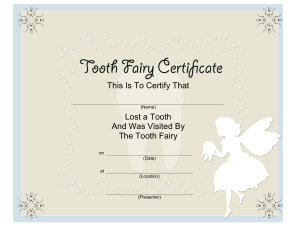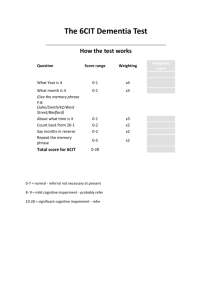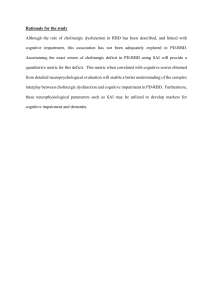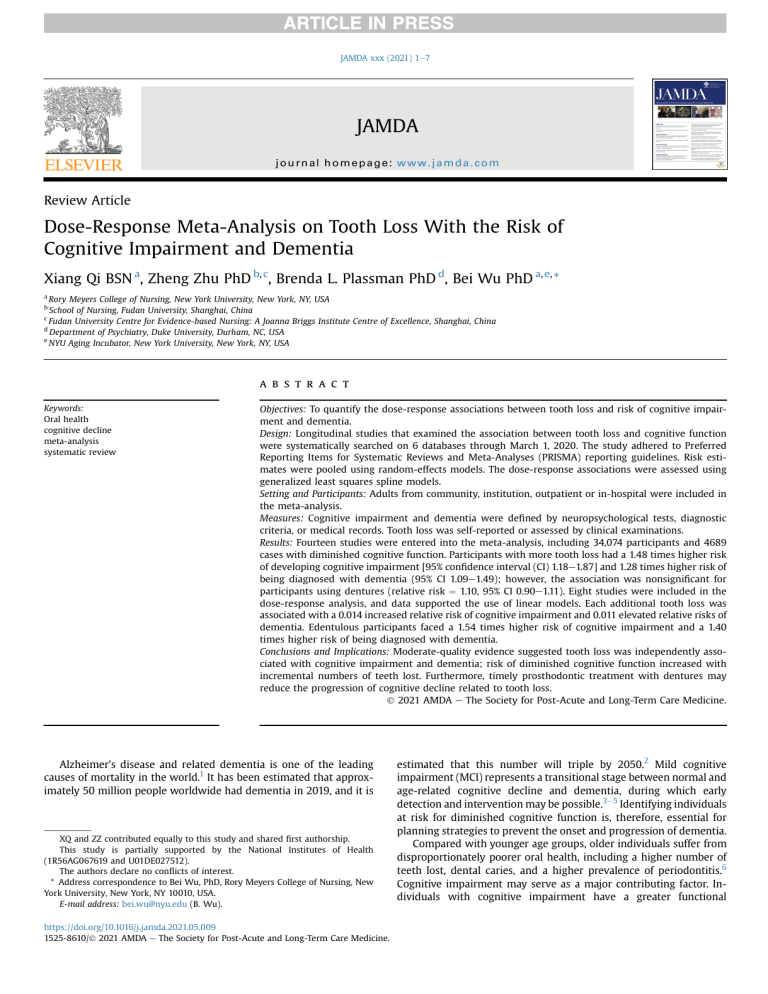
JAMDA xxx (2021) 1e7 JAMDA journal homepage: www.jamda.com Review Article Dose-Response Meta-Analysis on Tooth Loss With the Risk of Cognitive Impairment and Dementia Xiang Qi BSN a, Zheng Zhu PhD b, c, Brenda L. Plassman PhD d, Bei Wu PhD a, e, * a Rory Meyers College of Nursing, New York University, New York, NY, USA School of Nursing, Fudan University, Shanghai, China c Fudan University Centre for Evidence-based Nursing: A Joanna Briggs Institute Centre of Excellence, Shanghai, China d Department of Psychiatry, Duke University, Durham, NC, USA e NYU Aging Incubator, New York University, New York, NY, USA b a b s t r a c t Keywords: Oral health cognitive decline meta-analysis systematic review Objectives: To quantify the dose-response associations between tooth loss and risk of cognitive impairment and dementia. Design: Longitudinal studies that examined the association between tooth loss and cognitive function were systematically searched on 6 databases through March 1, 2020. The study adhered to Preferred Reporting Items for Systematic Reviews and Meta-Analyses (PRISMA) reporting guidelines. Risk estimates were pooled using random-effects models. The dose-response associations were assessed using generalized least squares spline models. Setting and Participants: Adults from community, institution, outpatient or in-hospital were included in the meta-analysis. Measures: Cognitive impairment and dementia were defined by neuropsychological tests, diagnostic criteria, or medical records. Tooth loss was self-reported or assessed by clinical examinations. Results: Fourteen studies were entered into the meta-analysis, including 34,074 participants and 4689 cases with diminished cognitive function. Participants with more tooth loss had a 1.48 times higher risk of developing cognitive impairment [95% confidence interval (CI) 1.18e1.87] and 1.28 times higher risk of being diagnosed with dementia (95% CI 1.09e1.49); however, the association was nonsignificant for participants using dentures (relative risk ¼ 1.10, 95% CI 0.90e1.11). Eight studies were included in the dose-response analysis, and data supported the use of linear models. Each additional tooth loss was associated with a 0.014 increased relative risk of cognitive impairment and 0.011 elevated relative risks of dementia. Edentulous participants faced a 1.54 times higher risk of cognitive impairment and a 1.40 times higher risk of being diagnosed with dementia. Conclusions and Implications: Moderate-quality evidence suggested tooth loss was independently associated with cognitive impairment and dementia; risk of diminished cognitive function increased with incremental numbers of teeth lost. Furthermore, timely prosthodontic treatment with dentures may reduce the progression of cognitive decline related to tooth loss. Ó 2021 AMDA e The Society for Post-Acute and Long-Term Care Medicine. Alzheimer’s disease and related dementia is one of the leading causes of mortality in the world.1 It has been estimated that approximately 50 million people worldwide had dementia in 2019, and it is XQ and ZZ contributed equally to this study and shared first authorship. This study is partially supported by the National Institutes of Health (1R56AG067619 and U01DE027512). The authors declare no conflicts of interest. * Address correspondence to Bei Wu, PhD, Rory Meyers College of Nursing, New York University, New York, NY 10010, USA. E-mail address: bei.wu@nyu.edu (B. Wu). https://doi.org/10.1016/j.jamda.2021.05.009 1525-8610/Ó 2021 AMDA e The Society for Post-Acute and Long-Term Care Medicine. estimated that this number will triple by 2050.2 Mild cognitive impairment (MCI) represents a transitional stage between normal and age-related cognitive decline and dementia, during which early detection and intervention may be possible.3e5 Identifying individuals at risk for diminished cognitive function is, therefore, essential for planning strategies to prevent the onset and progression of dementia. Compared with younger age groups, older individuals suffer from disproportionately poorer oral health, including a higher number of teeth lost, dental caries, and a higher prevalence of periodontitis.6 Cognitive impairment may serve as a major contributing factor. Individuals with cognitive impairment have a greater functional 2 X. Qi et al. / JAMDA xxx (2021) 1e7 dependency. They are often reliant on others for their daily oral care, and thus are more likely to have deficient oral hygiene, more periodontal disease, and greater tooth loss.7 Among the increasing number of cognitively impaired residents in long-term care facilities, the need for regular good oral hygiene care is further accentuated.8 Combined, these findings have led to increasing attention being devoted to understanding the association between tooth loss and diminished cognitive function.9e15 To our knowledge, 5 meta-analyses9,11e13,16 have been conducted to examine tooth loss and cognitive impairment; however, the conclusions from some systematic reviews were mixed,14e16 resulting in unanswered questions on whether an association exists, underlining the issue of the methodological quality from their synthesized evidence. First, the determination of incident dementia is inaccurate for those meta-analyses that included cross-sectional studies.11,13 Second, 2 meta-analyses13,16 did not present the quality appraisal of evidence using structured tools, leading to bias in reporting the synthesized result. Third, the level of cognitive and functional impairment differs between dementia and MCI or other forms of mild impairment; however, 4 meta-analyses failed to analyze cognitive impairment and dementia separately.11e13,16 Recently, a few studies have been conducted to examine tooth loss and the risk of cognitive impairment and/or dementia using longitudinal cohort data.17e19 We, therefore, conducted a meta-analysis using longitudinal studies, aiming to provide contemporary evidence investigating a dose-response association between tooth loss and the risk of cognitive impairment and dementia. Methods Protocol and Registration This meta-analysis protocol was registered in the National Institute for Health Research, International Prospective Register of Systematic Reviews (PROSPERO, registration number: CRD42019128023). The reporting of this study was in accordance with Preferred Reporting Items for Systematic Reviews and Meta-Analyses (PRISMA) Guideline (Supplementary Material 1).20 Search Strategy We searched 6 databases, including PubMed/MEDLINE, Medline (Ovid), EMBASE (Ovid), CINAHL (EBSCO), Web of Science, and Cochrane Library (Wiley), up to March 1, 2020. A search strategy was developed for each database using a combination of free text and controlled vocabulary terms (Supplementary Material 2). The reference lists of included studies were also screened as a supplement to searching the databases. Study Selection Inclusion criteria were as follows: (1) longitudinal studies that examined the association between tooth loss and cognitive impairment or dementia; (2) the exposure was tooth loss, and the outcome was cognitive impairment/decline, or any types of dementia/Alzheimer disease; (3) with empirical data as follows: beta-coefficient (b), odds ratio (OR), relative risk (RR), hazard ratio (HR) with 95% confidence interval (CI)/standard error (SE) or enough information for calculating b, OR, RR, or HR; (4) published in peer-reviewed English language journals. Any type of setting, including but not limited to community, institution, outpatient or in-hospital, were eligible. Exclusion criteria: articles that included only children and adolescents. Considering duplicates and studies reporting on the same cohort, we only kept the latest publication or the study with the larger sample size, longer follow-up period, and with more confounders adjusted. Titles and abstracts were screened against inclusion and exclusion criteria. The full texts of selected studies were assessed by 2 independent reviewers (X.Q. and Z.Z.). Any conflicts between the reviewers were resolved by a third reviewer (B.W.). Data Extraction and Quality Assessment Two reviewers independently (X.Q. and Z.Z.) extracted information from articles, including authors, publication year, geographic region, study design, study setting, sample demographics (age, gender), follow-up period, tooth loss measures and cognitive assessment, adjustment for covariates, and main findings. Discrepancies were solved through group discussion. We applied the Newcastle-Ottawa Scale (NOS) for case-control and cohort studies to assess the risks of bias. Assessment tools were selected in accordance with the study designs encountered. One point was assigned for the presence of a quality feature, with scores ranging from 1 to 9.21 Studies with NOS scores of 1 to 3 were defined as poor quality, 4 to 6 intermediate, and 7 to 9 high. The quality of evidence for each outcome was evaluated using the Grading of Recommendations Assessment, Development and Evaluation (GRADE) approach.22 Statistical Analysis We examined the association between tooth loss and cognitive impairment or dementia through pooling RRs and corresponding 95% CIs for the highest risk versus the lowest risk. RR was regarded as equivalent to HR and OR, as there is a low prevalence of cognitive impairment and dementia in the combined sample of this study all populations (ie, <20%).23 We used random-effects meta-analysis and quantified heterogeneity among studies using the Q test and I2 statistic. In addition, subgroup analysis and meta-regression were performed to explore the source of heterogeneity. The possibility of publication bias was evaluated using the Begg rank correlation test and the Egger linear regression test. Dose-response analyses were performed using the method described by Greenland and Longnecker.24 Only studies with at least 3 quantitative categories of tooth loss were included. We assigned the median level of numbers of teeth lost in each category to the corresponding RRs. If the highest or lowest categories were open-ended, we set the highest boundary to 32 teeth intact (unless specified) and the lowest boundary to complete edentulous. We applied a restricted cubic spline model with 3 knots at 10th, 50th, and 90th percentiles to evaluate the potential nonlinear relationship.25 The linear and nonlinear models were also compared by using a 2-stage randomeffects model. Results were considered significant at 2-tailed P < .05. All data analyses were conducted using Stata 15.1 software (Stata Corp, College Station, TX). Results Literature Search Fourteen studies were identified in this review. The study selection process and the literature search results are depicted in Supplementary Material 3. Among the 14 articles, 3 articles conducted separate analyses on either education level (higher and lower),26 cognitive function (cognitive impairment and dementia),27 or gender (male and female);28 therefore, the final meta-analysis contained 17 datasets. Eight studies were included in the dose-response analysis.27e34 X. Qi et al. / JAMDA xxx (2021) 1e7 3 Assessment of Tooth Loss Assessment of Cognitive Impairment and Dementia All included studies evaluated tooth loss as exposure of interest. The number of teeth lost was assessed through clinical examinations in 9 studies,18,19,26,29e33,35 and from the self-reported number of teeth lost in 5 studies.3,17,27,28,34 Incident dementia was the cognitive outcome in 8 studies.3,26,28,31e35 The diagnosis of dementia was based on Diagnostic and Statistical Manual of Mental Disorders, third edition revised/fourth edition (DSM-III R/IV) in 4 studies,26,32,33,35 medical records and death Fig. 1. Forest plot of tooth loss and risk of cognitive impairment (A) and dementia (B). Studies are pooled with a random-effects model; HEL, higher education level, LEL, lower education level. 4 X. Qi et al. / JAMDA xxx (2021) 1e7 certificates in 2 studies,3,28 data from a long-term care insurance database that included in-person standardized questionnaires reviewed by a group of clinicians,34 or assessment of cognitive and functional ability using standardized measures including a battery of neuropsychological tests.31 In 5 studies, the reported outcome was the incidence of cognitive impairment.17e19,29,30 Mini-Mental State Examination (MMSE) or a single MMSE item was the most common measurement in 4 studies,17,19,29,31 followed by the Japanese version of the Montreal Cognitive Assessment.18 One study27 reported both the measurement of cognitive impairment and dementia, DSM-IV was used to diagnose dementia, and cognitive impairment was measured by MMSE. Selected Studies and Characteristics Detailed characteristics of the included studies are shown in Supplementary Material 4. Nine were prospective17e19,26,27,29,30,33,34 and 3 were retrospective cohort studies,28,31,32 and 2 were casecontrol nested in cohort studies.3,35 Six studies were conducted in Japan,18,19,29,30,33,34 followed by the United States (3),28,31,32 Sweden (2),3,17 France (1),26 Korea (1),35 and United Kingdom (1).27 All studies were conducted among community-dwelling older adults, except one that was from an institutional setting.30 The sample sizes of studies varied from 14019 to 11,140.27 The average age of participants ranged from 65.827 to 84.0.31 Risk of Bias The overview of the quality appraisal of included studies is presented in Supplementary Material 5. Five cohorts were followed for more than 10 years,26,28,31,32,35 and in 4 studies less than 5 years.18,31,34,35 The mean quality score of the included studies is 7.6 1.3. For 12 cohort studies, the results showed the methodological deficiency was that attrition was not accounted for in the follow-up cohort,18,19,27 and tooth loss was self-reported in 5 of the studies.3,17,27,28,34 Four studies did not control the participants’ age or gender.18,26,28,34 Two studies were conducted on female individuals only.31,32 The 2 nested case-control studies failed to provide the information on the nonresponse rate.3,35 Association Between Tooth Loss and Risk of Cognitive Impairment and Dementia Six studies17e19,27,29,30 compared the incidence of cognitive impairment between subjects with more teeth lost versus fewer teeth lost. The pooled adjusted RR revealed that participants with more teeth lost had 1.48 times higher risk of developing impairment (95% CI 1.18e1.87) compared with fewer teeth lost (Figure 1A). Nine studies examined the association between tooth loss and incident dementia.3,26e28,31e35 Participants with more teeth lost had 1.28 times higher risk of being diagnosed with dementia (95% CI 1.09e1.49) (Figure 1B). Linear Dose-Responses Association Analysis The analysis investigating the dose-response relationship between tooth loss and cognitive impairment was based on 3 studies (Figure 2A).27,29,30 A linear relationship was detected (P ¼ .81 for nonlinearity), and the analysis suggested that every missing tooth increased the RR of cognitive impairment by 1.01 times (95% CI 1.01e1.02). The risk increased to 1.31 times when the number of missing teeth went up to 20 (95% CI 1.20e1.43). Edentulous participants faced 1.54 times higher risk of cognitive impairment (95% CI 1.34e1.78). We examined the dose-response relationship between tooth loss and dementia using 6 studies.27,28,31e34 No evidence of Fig. 2. Dose-response analysis of each 1 tooth loss increment and risk of cognitive impairment (A), dementia (B). The solid lines describe point estimates of the association between tooth loss and cognitive impairment or dementia risk; the dashed lines represent 95% CIs. nonlinearities was observed (P ¼ .70 for nonlinearity). Each additional tooth loss was associated with a 1.01 higher dementia RR (95% CI 1.00e1.02) (Figure 2B). Accordingly, edentulous participants faced a 1.40 times higher risk of dementia (95% CI 1.10e1.80). Subgroup Analysis and Meta-Regression To confirm the robustness of our study findings, we conducted subgroup analysis and meta-regression on possible sources of heterogeneity. Our subgroup analysis revealed that the association between tooth loss and the risk of diminished cognitive function was not substantially changed by study design, study setting, geographic region, sample size, follow-up period, self-reported versus clinically examined tooth loss, and score quality (Table 1). However, significant differences were detected when stratified by denture status. Ten datasets obtained from 4 publications were used to analyze the risk of cognitive decline among tooth loss participants with and without dentures.28,30,34,35 The result showed a distinct association for the without-denture group only (with denture: RR 1.00, 95% CI 0.90e1.11; without denture: RR 1.55, 95% CI 1.24e1.94). The results of multivariate meta-regression showed that study design, study setting, geographic region, sample size, follow-up X. Qi et al. / JAMDA xxx (2021) 1e7 5 Table 1 Subgroup Analysis of the RR of Cognitive Impairment and Dementia Overall and Subgroup Analysis No. of Reports RR (95% CI) Effect Model I2, % Total Study design Prospective cohort Retrospective cohort Nested case-control Study setting Community Institution Geographic region Europe America Asia Sample size >1000 1000 Follow-up period, y 10 <10 Denture status With denture Without denture Tooth loss assessment Clinical examination Self-reported NOS score quality High quality (score 7e9) Intermediate quality (score 4e6) Low quality (score 1e3) 17 1.34 (1.19e1.51) Random 48.7 .01 13 4 2 1.35 (1.13e1.62) 1.20 (1.06e1.35) 1.35 (1.14e1.61) Random Fixed Fixed 58.9 0.00 33.7 .01 .35 .21 16 1 1.33 (1.18e1.50) 2.40 (0.89e6.45) Random / 49.7 / .01 / 6 4 7 1.29 (1.08e1.54) 1.28 (1.10e1.47) 1.50 (1.16e1.95) Random Fixed Random 62.1 33.7 49.8 .02 .21 .06 9 8 1.34 (1.18e1.52) 1.31 (1.10e1.55) Random Random 55.3 48.2 .03 .05 6 11 1.15 (1.02e1.28) 1.38 (1.27e1.49) Random Fixed 57.8 35.4 .04 .12 5 5 1.00 (0.90e1.11) 1.55 (1.24e1.94) Fixed Fixed 0.0 0.0 .70 .47 10 7 1.49 (1.13e1.98) 1.31 (1.21e1.43) Random Fixed 57.7 34.3 .01 .17 14 3 0 1.33 (1.12e1.58) 1.41 (1.27e1.57) / Random Fixed / 54.6 0 / .01 .75 / period, self-reported versus clinically examined tooth loss, age, gender, adjustment for covariates, and score quality did not affect the risk of cognitive decline (all P > .1). Publication Bias The symmetry in Supplementary Material 6 is not perfect when the outcome is cognitive impairment, but still implied the absence of significant publication bias, which was confirmed by the Egger test (P ¼ .13) and Begg rank correlation test (P ¼ .19). The funnel plot is symmetrical when the outcome is dementia (Supplementary Material 6). We did not observe significant publication biases in our included studies, neither in Begg rank correlation test (P ¼ .81) nor in the Egger linear regression test (P ¼ .94). Quality of Evidence The quality of the evidence was moderate for the associations owing to the presence of dose-response gradients. Despite that the quality of evidence started from “low” because the included studies were all observational,22 the dose-response gradient upgrades the quality of evidence for the 2 outcomes by 1 level (Table 2). P for Heterogeneity Discussion This meta-analysis revealed the association between tooth loss and risk of cognitive impairment and dementia based on 14 longitudinal studies containing 34,074 participants and 4689 cases with diminished cognitive function. Our results indicated that more tooth loss increased the risk of cognitive impairment by 1.48 times and dementia by 1.28 times, even after controlling for a range of potential confounders. A further dose-response analysis detected linear associations between tooth loss and cognitive impairment or dementia, suggesting that the more teeth missing, the higher the risk of cognitive impairment and dementia. In subgroup analysis and metaregression, we found that the association between tooth loss and cognitive impairment was affected by denture status. The quality of evidence was “moderate” for the association between tooth loss and cognitive impairment and dementia owing to the dose-response gradients.22 We also detected a higher incidence of cognitive impairment or dementia among 3567 edentulous participants without dentures (23.8%) compared with those with dentures (16.9%). The differential risks of cognitive impairment/dementia based on denture status may be explained by the alteration of chewing ability.28,30,34,35 A recent large-scale cohort study on Chinese older adults found that denture Table 2 Quality and Strength of Evidence for 3 Outcomes Outcomes Anticipated Absolute Effects (95% CI) Risk With Fewer Tooth Loss Risk With More Tooth Loss Cognitive impairment Follow-up: mean 5.3 years 124 per 1000 180 per 1000 (159 to 201) Dementia follow-up: mean 11.9 years 112 per 1000 143 per 1000 (121 to 165) Relative Effect (95% CI) No. of Participants (Studies) RR 1.48 (1.18 to 1.87) 17,310 (6 observational studies*) 27,904 (9 observational studies*) RR 1.28 (1.09 to 1.49) *The study of Batty et al., 2013,27 reported both the measurement of cognitive impairment and dementia. Quality of Evidence (GRADE) MODERATE MODERATE 6 X. Qi et al. / JAMDA xxx (2021) 1e7 use attenuated the detrimental effects of tooth loss, especially for partial tooth loss, on cognitive impairment.36 The putative protective effect of denture use on cognitive impairment was also demonstrated in a few population-based studies.37,38 For instance, cross-sectional studies suggested that both the retention of natural teeth and the rehabilitation of the missing teeth37 with prostheses such as dentures and guaranteeing functional denture quality38 could attenuate cognitive impairment. Multiple explanations have been offered for the association between tooth loss and diminished cognitive function. Consistent with the apparent benefit of denture use, some have proposed that masticatory dysfunction after tooth loss may promote morphologic or cholinergic changes in specific brain regions related to cognition.39e42 Another possible explanation is that tooth loss and suboptimal masticatory function contribute to nutritional deficiencies, leading to loss of key nutrients for brain health. For example, vitamin D has been reported to inhibit the activity of certain cytokines related to periodontal disease and dementia by reducing the expression of interleukin-6, interleukin-8, and tumor necrosis factor-a.43,44 Finally, the proposed role of oral inflammation and pathogenic oral bacteria, such as Porphyromonas gingivalis, on neuroinflammatory processes and beta-amyloid production has received increasing attention as a possible mechanism.45e47 Periodontitis, an etiological factor of tooth loss, also stimulates the release of inflammatory cytokines that are related to the activation of molecules contributing to the progression of dementia, such as C-reactive protein, tumor necrosis factor-a, immunoglobulin G, interleukin-1b, and interleukin-6.48e50 Despite the numerous posited mechanisms for the association between tooth loss and dementia,51 none of them have yet gained sufficient empirical support. Tooth loss may also reflect life-long socioeconomic disadvantages, such as limited access to and quality of medical and dental care, fewer years of education, and poor nutrition. Some of these factors are themselves associated with a greater risk of cognitive impairment in later life.52,53 In addition, we cannot exclude the possibility of reverse causality being the explanation for our findings. Previous cohort studies found that cognitive decline was associated with infrequent toothbrushing, plaque deposit, and increased odds of edentulism.54,55 Cognitive impairment may increase the risk of tooth loss due to poor oral hygiene among people living with dementia.7 The strengths of this meta-analysis lie in several aspects. First, our study targeted longitudinal studies, which may reduce the sampling error and recall bias.56 In addition, we found a dose-response association between tooth number and risk of diminished cognitive function, thus substantially strengthening the evidence linking tooth loss to cognitive impairment and providing some evidence for a causal association.24 The subgroup analysis and meta-regression also were conducted to clarify possible confounders affecting the result. Evaluation of publication bias indicated that it did not impact the final results. We thus conclude that tooth loss is associated with the risk of incident cognitive impairment and can be regarded as a risk factor for cognitive impairment and dementia. Limitations Limitations of this study need to be acknowledged. First, although the longitudinal design allows us to comment on the direction of the association between tooth loss and cognitive decline, heterogeneity across different studies still exists, such as the different methodological approaches and range of indicators used to assess cognitive function. Second, we should be cautious when interpreting the synthesized results because 3 of the cohort studies did not report the attrition rate. Third, the NOS tool’s decision rules are vague, difficult to use, and of questionable reliability in observational studies.57 In our meta-analysis, the NOS rating criteria for the outcome (cognitive assessment in cohort studies) did not allow for capturing the variety of factors that influence the validity of the cognitive outcome, which might lead to an underestimated risk of bias of the included studies. Conclusions and Implications In summary, this study provided further support of tooth loss as a risk factor for cognitive impairment and dementia. Furthermore, this review highlights that maintaining good oral health may help preserve cognitive function. The findings also indicate that timely prosthodontic treatment may slow the progression of cognitive decline. In clinical practice, health professionals can play an important role in educating patients and family members on the importance of improving oral health. Implementation of population-based oral health promotion programs and interventions have the potential to benefit a range of health issues, including cognitive health. Author Contributions Xiang Qi had full access to all of the data in the study and takes responsibility for the integrity of the data and the accuracy of the data analysis. Concept and design: Bei Wu. Acquisition, analysis, and interpretation of data: Xiang Qi and Zheng Zhu. Drafting of the manuscript: Xiang Qi. Critical revision of the manuscript for important intellectual content: Brenda L. Plassman, Bei Wu. Statistical analysis: Xiang Qi. Obtained funding: Bei Wu. Supervision: Bei Wu. References 1. Nichols E, Vos T. Estimating the global mortality from Alzheimer’s disease and other dementias: A new method and results from the Global Burden of Disease study 2019: Epidemiology/prevalence, incidence, and outcomes of MCI and dementia. Alzheimers Dement 2020;16:e042236. 2. Matthews KA, Xu W, Gaglioti AH, et al. Racial and ethnic estimates of Alzheimer’s disease and related dementias in the United States (2015e2060) in adults aged 65 years. Alzheimers Dement 2019;15:17e24. 3. Gatz M, Mortimer JA, Fratiglioni L, et al. Potentially modifiable risk factors for dementia in identical twins. Alzheimers Dement 2006;2(2):110e117. 4. Petersen RC, Morris JC. Mild cognitive impairment as a clinical entity and treatment target. Arch Neurol 2005;62:1160. 5. Werner P. Mild cognitive impairment: Conceptual, assessment, ethical, and social issues. Clin Interv Aging 2008;3:413e420. 6. Griffin SO, Jones JA, Brunson D, et al. Burden of oral disease among older adults and implications for public health priorities. Am J Public Health 2012;102: 411e418. 7. Delwel S, Binnekade TT, Perez RSGM, et al. Oral hygiene and oral health in older people with dementia: A comprehensive review with focus on oral soft tissues. Clin Oral Investig 2018;22:93e108. 8. Boyd M, Broad JB, Kerse N, et al. Twenty-year trends in dependency in residential aged care in Auckland, New Zealand: A descriptive study. J Am Med Dir Assoc 2011;12:535e540. 9. Cerutti-Kopplin D, Feine J, Padilha DM, et al. Tooth loss increases the risk of diminished cognitive function: A systematic review and meta-analysis. JDR Clin Transl Res 2016;1:10e19. 10. Daly B, Thompsell A, Sharpling J, et al. Evidence summary: The relationship between oral health and dementia. Br Dent J 2017;223:846e853. 11. Fang W, Jiang M, Gu B, et al. Tooth loss as a risk factor for dementia: Systematic review and meta-analysis of 21 observational studies. BMC Psychiatry 2018; 18:345. 12. Oh B, Han D-H, Han K-T, et al. Association between residual teeth number in later life and incidence of dementia: A systematic review and meta-analysis. BMC Geriatr 2018;18:48. 13. Shen T, Lv J, Wang L, et al. Association between tooth loss and dementia among older people: A meta-analysis: Association between tooth loss and dementia among older people. Int J Geriatr Psychiatry 2016;31:953e955. 14. Tonsekar PP, Jiang SS, Yue G. Periodontal disease, tooth loss and dementia: Is there a link? A systematic review. Gerodontology 2017;34:151e163. 15. Wu B, Fillenbaum GG, Plassman BL, Guo L. Association between oral health and cognitive status: A systematic review. J Am Geriatr Soc 2016;64:739e751. 16. Chen J, Ren C-J, Wu L, et al. Tooth loss is associated with increased risk of dementia and with a dose-response relationship. Front Aging Neurosci 2018; 10:415. X. Qi et al. / JAMDA xxx (2021) 1e7 17. Dintica CS, Rizzuto D, Marseglia A, et al. Tooth loss is associated with accelerated cognitive decline and volumetric brain differences: A population-based study. Neurobiol Aging 2018;67:23e30. 18. Hatta K, Ikebe K, Gondo Y, et al. Influence of lack of posterior occlusal support on cognitive decline among 80-year-old Japanese people in a 3-year prospective study: Influence of occlusion on cognition. Geriatr Gerontol Int 2018; 18:1439e1446. 19. Saito S, Ohi T, Murakami T, et al. Association between tooth loss and cognitive impairment in community-dwelling older Japanese adults: A 4-year prospective cohort study from the Ohasama study. BMC Oral Health 2018;18:142. 20. Moher D, Liberati A, Tetzlaff J, Altman DG. The PRISMA Group. Preferred reporting items for systematic reviews and meta-analyses: The PRISMA Statement. PLoS Med 2009;6:e1000097. 21. Stang A. Critical evaluation of the Newcastle-Ottawa Scale for the assessment of the quality of non-randomized studies in meta-analyses. Eur J Epidemiol 2010;25:603e605. 22. Guyatt GH, Oxman AD, Vist GE, et al. GRADE: An emerging consensus on rating quality of evidence and strength of recommendations. BMJ 2008;336:924e926. 23. Higgins JPT, Thomas J, Chandler J, et al. Cochrane Handbook for Systematic Reviews of Interventions. 2nd. Chichester (UK): John Wiley & Sons; 2019. 24. Greenland S, Longnecker MP. Methods for trend estimation from summarized dose-response data, with applications to meta-analysis. Am J Epidemiol 1992; 135:1301e1309. 25. Harre FE, Lee KL, Pollock BG. Regression models in clinical studies: Determining relationships between predictors and response. J Natl Cancer Inst 1988;80: 1198e1202. 26. Arrivé E, Letenneur L, Matharan F, et al. Oral health condition of French elderly and risk of dementia: A longitudinal cohort study: Elderly’s oral health and risk of dementia. Community Dent Oral Epidemiol 2012;40:230e238. 27. Batty G-D, Li Q, Huxley R, et al. Oral disease in relation to future risk of dementia and cognitive decline: Prospective cohort study based on the action in diabetes and vascular disease: Preterax and Diamicron Modified-Release Controlled Evaluation (Advance) Trial. Eur Psychiatry 2013;28:49e52. 28. Paganini-Hill A, White SC, Atchison KA. Dentition, dental health habits, and dementia: The Leisure World Cohort Study. J Am Geriatr Soc 2012;60: 1556e1563. 29. Okamoto N, Morikawa M, Tomioka K, et al. Association between tooth loss and the development of mild memory impairment in the elderly: The Fujiwara-kyo Study. J Alzheimers Dis 2015;44:777e786. 30. Shimazaki Y, Soh I, Saito T, et al. Influence of dentition status on physical disability, mental impairment, and mortality in institutionalized elderly people. J Dent Res 2001;80:340e345. 31. Stein PS, Desrosiers M, Donegan SJ, et al. Tooth loss, dementia and neuropathology in the Nun Study. J Am Dent Assoc 2007;138:1314e1322. 32. Stewart R, Stenman U, Hakeberg M, et al. Associations between oral health and risk of dementia in a 37-year follow-up study: The prospective population study of women in Gothenburg. J Am Geriatr Soc 2015;63:100e105. 33. Takeuchi K, Ohara T, Furuta M, et al. Tooth loss and risk of dementia in the community: The Hisayama Study. J Am Geriatr Soc 2017;65:e95ee100. 34. Yamamoto T, Kondo K, Hirai H, et al. Association between self-reported dental health status and onset of dementia: A 4-year prospective cohort study of older Japanese adults from the Aichi Gerontological Evaluation Study (AGES) Project. Psychosom Med 2012;74:241e248. 35. Kim J-M, Stewart R, Prince M, et al. Dental health, nutritional status and recentonset dementia in a Korean community population. Int J Geriatr Psychiatry 2007;22:850e855. 7 36. Yang H-L, Li F-R, Chen P-L, et al. Tooth loss, denture use, and cognitive impairment in Chinese older adults: A community cohort study. J Gerontol A Biol Sci Med Sci; 2021:glab056 [E-pub ahead of print]. 37. Shin M, Shin YJ, Karna S, Kim H. Rehabilitation of lost teeth related to maintenance of cognitive function. Oral Dis 2019;25:290e299. 38. Cerutti-Kopplin D, Emami E, Hilgert JB, et al. Cognitive status of edentate elders wearing complete denture: Does quality of denture matter? J Dent 2015;43: 1071e1075. 39. Kubo K, Ichihashi Y, Kurata C, et al. Masticatory function and cognitive function. Okajimas Folia Anat Jpn 2010;87:135e140. 40. Chen H, Iinuma M, Onozuka M, Kubo K-Y. Chewing maintains hippocampusdependent cognitive function. Int J Med Sci 2015;12:502e509. 41. Utsugi C, Miyazono S, Osada K, et al. Hard-diet feeding recovers neurogenesis in the subventricular zone and olfactory functions of mice impaired by softdiet feeding. PLoS One 2014;9:e97309. 42. Katayama T, Mori D, Miyake H, et al. Effect of bite-raised condition on the hippocampal cholinergic system of aged SAMP8 mice. Neurosci Lett 2012;520: 77e81. 43. Tang X, Pan Y, Zhao Y. Vitamin D inhibits the expression of interleukin-8 in human periodontal ligament cells stimulated with Porphyromonas gingivalis. Arch Oral Biol 2013;58:397e407. 44. Jayedi A, Rashidy-Pour A, Shab-Bidar S. Vitamin D status and risk of dementia and Alzheimer’s disease: A meta-analysis of dose-response. Nutr Neurosci 2019;22:750e759. 45. Singhrao SK, Olsen I. Are Porphyromonas gingivalis outer membrane vesicles microbullets for sporadic Alzheimer’s disease manifestation? J Alzheimers Dis Rep 2018;2:219e228. 46. Nie R, Wu Z, Ni J, et al. Porphyromonas gingivalis infection induces amyloid-b accumulation in monocytes/macrophages. J Alzheimers Dis 2019;72: 479e494. 47. Dominy SS, Lynch C, Ermini F, et al. Porphyromonas gingivalis in Alzheimer’s disease brains: Evidence for disease causation and treatment with smallmolecule inhibitors. Sci Adv 2019;5:eaau3333. 48. Kaye EK, Valencia A, Baba N, et al. Tooth loss and periodontal disease predict poor cognitive function in older men: Periodontal disease and cognitive function. J Am Geriatr Soc 2010;58:713e718. 49. Noble JM, Scarmeas N, Celenti RS, et al. Serum IgG antibody levels to periodontal microbiota are associated with incident Alzheimer disease. PLoS One 2014;9:e114959. 50. Abbayya K, Chidambar Y, Naduwinmani S, Puthanakar N. Association between periodontitis and Alzheimer0 s disease. North Am J Med Sci 2015;7:241. 51. Weijenberg RAF, Delwel S, Ho BV, et al. Mind your teethdthe relationship between mastication and cognition. Gerodontology 2019;36:2e7. 52. Rogers MAM, Plassman BL, Kabeto M, et al. Parental education and late-life dementia in the United States. J Geriatr Psychiatry Neurol 2009;22:71e80. 53. Thomson WM, Barak Y. Tooth loss and dementia: A critical examination. J Dent Res 2021;100:226e231. 54. Naorungroj S, Slade GD, Beck JD, et al. Cognitive decline and oral health in middle-aged adults in the ARIC study. J Dent Res 2013;92:795e801. 55. Kang J, Wu B, Bunce D, et al. Cognitive function and oral health among ageing adults. Community Dent Oral Epidemiol 2019;47:259e266. 56. Caruana EJ, Roman M, Hernández-Sánchez J, Solli P. Longitudinal studies. J Thorac Dis 2015;7:E537eE540. 57. Hartling L, Milne A, Hamm MP, et al. Testing the Newcastle Ottawa Scale showed low reliability between individual reviewers. J Clin Epidemiol 2013;66: 982e993.
